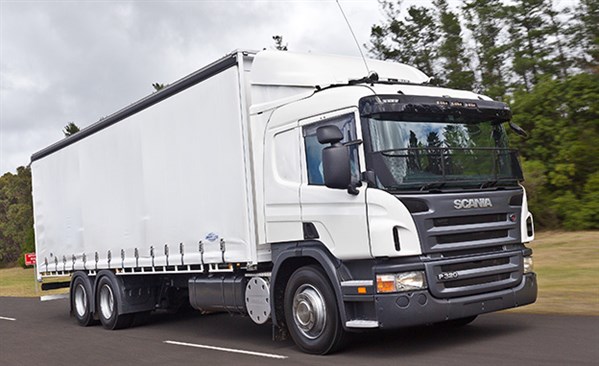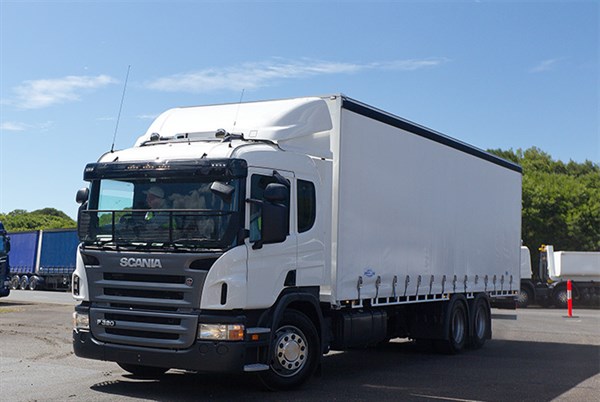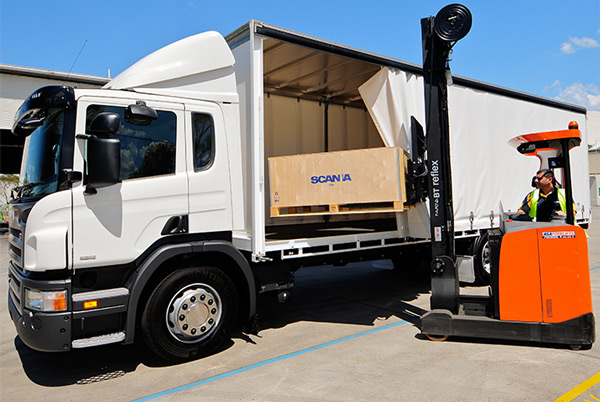Urban transport is a happy hunting ground for trucks with 6x4 drivelines, but Scania has just unveiled its latest weapon in the war to convert operators to single drive, the P320.
The latest weapon in Scania’s armoury is the P-Series range, available as either a rigid truck or prime mover, with the rigid version also offered to local operators under the ‘ready built’ scheme where both chassis and body are ready for immediate delivery to operators.
The ‘ready built’ models are ordered from the factory in Sweden at the same time as a standard body, in this case a 14-pallet curtainsider with load restraint curtains, is ordered from Freighter, with the two units arriving together at the dealership, ready for delivery to a customer.
The P-Series showcases Scania’s efforts to smooth out the aerodynamics of cabover trucks, with rounded edges helping to reduce the frontal area pushing through the air, while the curved windscreen angles backwards to guide the air around the cab.
Also helping improve the aerodynamic efficiency of the P-Series is the low ride height, which also makes cab entry and exit easier, an important factor for drivers constantly entering and exiting the cab as part of their working day.
Typical Scania design clues abound, with the doors featuring ‘scalloping’ to direct air under the window line to keep them clear of road grime, along with the air scoops mounted on the radiator grille support panels.
The mirror clusters are large, but sturdily mounted, eliminating vibration-induced blurring, although they offer a comprehensive view of what is happening behind the driver. The sheer size of the clusters does cause blind spots, especially on the driver’s side.
The door windows are single piece units, with no quarter vents or frames to obscure the driver’s view, while the mirror support brackets sit out from the door, making it easy to run a squeegee across the glass to maintain clear vision.
Although the smallest truck in the Scania range, the P-Series retains a family look, employing the same goblet-shaped horizontal grille design as the larger G- and R-Series models, with wide horizontal slats pushing air across the radiator.
The grille is in two pieces, with the top section opening upwards for access to the radiator and oil dipstick to make daily checks easier, while the bottom section doubles as a step for cleaning the windscreen.
In keeping with the truck’s low profile, the headlights and indicators are mounted just above the bumper, flanking the lower grille, with the park light and indicator outboard of the new H4 headlight units.
The external fit and finish is up to usual Scania standards, with fine tolerances on the panel gaps, while the door and windows seal tight when closed, with blemish-free paint on the external surfaces.
Engine
With new emission regulations aimed at reducing or eliminating noxious gases from the exhaust fumes, Scania’s engine designers have opted to extract more efficiency from a smaller engine, in this case a five-cylinder unit with a capacity of 9 litres.
Despite the relatively small size, the DC9 engine pushes out 235kW at 1,900rpm and 1,600Nm of torque between 1,000 and 1,200rpm.
Power delivery is smooth, while the five-cylinder arrangement provides a muscular edge to the engine note, without creating any driveline vibration or shudder from the piston arrangement.
Transmission
The P320 puts the power to the bitumen through a GRS895 12-speed transmission, featuring direct drive for excellent low speed pick-up, with a final drive ratio of 3.08:1 to provide a fuel saving capability on extended highway runs.
The transmission is also fitted with the Opticruise computer-controlled clutch actuation, allowing the driver the option of fully automated shifts in automatic mode, or ‘fly-by-wire’ manual shifting using the wand-mounted on the steering column.
While the computer executes flawless shifts, even under full throttle, there is a definite power interruption as the change is made, which can slow forward momentum, especially on hill climbs.
The other inherent weakness of computer-controlled shifts is the gearbox is unable to skip gears when accelerating, although this is less of an issue for the direct-drive transmission, as each ratio provides constant acceleration.
It becomes more noticeable if the driver lifts off mid-way through acceleration, for example if traffic suddenly slows, as the transmission will then ‘hunt’ between ratios trying to find the most fuel-efficient gear for the road speed.
This is not restricted to Scania, all automated manual transmissions (AMTs) share this trait due to the inability of the computer to ‘see’ the road or traffic conditions; instead, it is responding to the driver’s previously measured throttle inputs.
Cab and Controls
Despite its status as the ‘smallest’ Scania, the P- cab is still roomy, with plenty of head and shoulder space for the driver and passenger.
The low entry design means entry and exit is simple, with just two steps into the cab, complemented by the steering wheel’s ability to lock in a horizontal position, while the air-suspended seat can be dropped to just above floor height.
The cab interior is dominated by the large engine hump that effectively separates the driver and passenger, a by-product of the lowered chassis, while the driver faces a standard instrument cluster shared with other models.
This commonality allows drivers to switch between models without needing to relearn the position of vehicle controls, so that fleets can have a mix of rigids and prime movers without fear of driver confusion.
The instruments are clear and easy to read, with big dials for speedo and tacho, flanked by smaller gauges for air brake pressures, fuel and temperature, with a central colour LCD display with selectable screens for driver support, trip details, service information, rear axle load, and also the gear position indicator.
The steering wheel has controls for the dash, cruise and audio systems, allowing full control of the truck without taking a hand off the wheel, while there are column-mounted stalks for the gear selector and indicators and wipers.
The cab is well-appointed, with high-quality vinyls and plastics on the dash, engine cover and door panels, while the seats are trimmed in a hard wearing, but breathable, fabric for long life and driver comfort.
In keeping with the truck’s ability to work on inter-urban as well as intra-urban tasks the cab is fitted with an ADR-compliant sleeper, although the engine hump provides a slight degree of difficulty for access, however this is offset by the previously mentioned ability of the seat and steering wheel to create additional crawl space.
In this guise the P-Series has a flat roof, so taller drivers will struggle to stand upright on the tunnel, particularly for changing shirts, however the cab is not claustrophobic.
The sleeper also allows an under-bunk fridge, with a slide-out tray, to be fitted as standard, this offers plenty of room for the driver to keep two meals and a supply of drinks cold, and within easy reach while driving.
The cab does offer plenty of oddment storage with a variety of overhead lockers and door pockets, able to hold everything from a wallet or telephone to a document wallet or log book.
The biggest omission in this regard is the lack of cup holders in this variant, while other P- cabs have one either side of the engine cover, it appears the box was not ticked on this version as there are filler panels covering the cup holder spaces.
Performance
Despite many preconceptions of operators against single-drive applications, the P320 proved to be the master of all surfaces encountered, regardless of the ruts or inclines, even with a 20-tonne running weight.
The secret is the electronically-controlled load sharing rear suspension, allowing weight to be transferred from the lazy axle and onto the drive as needed to ensure maximum traction, avoiding ‘hang ups’ where the drive axle is left spinning with no grip.
The ride itself is good — the combination of parabolic leaf at the front and four-bag air suspension at the rear soaking up the worst of Melbourne’s industrial roads, including around the Altona oil refinery where poor road maintenance and heavy trucks have transformed the bitumen into a moonscape of potholes and craters.
This is not to say the occupants are immune to being shaken and stirred, simply that the suspension works to absorb the worst of each impact so there is never a fear of loss of control from having too-stiff suspension pitch the truck across the road.
The P-Series is offered with all-wheel disc brakes supported by electronic signalling (EBS) and anti-lock brakes (ABS), while traction control also helps keep the truck stable, with a hill holder function to maintain braking pressure while the automated clutch takes up the slack.
The brakes work well, providing plenty of stopping power, with steady deceleration, although there is no activation switch for the exhaust brake, or any way of gauging when it intervenes, to allow the driver to use the exhaust brake for minor speed adjustments.
Brake feel is reasonable for a truck with air brakes and ABS. It is still difficult to get an accurate feel for how much stopping power is being used, however the end result is the truck stops on request.
A definite highlight of the truck was the steering, the power assistance takes away the need for muscling the truck around corners, yet it remains sensitive to driver inputs, with only minimal vagueness at the straight ahead position.
The steering feedback is excellent, the steering remains predictable at all speeds so that even novice drivers will feel comfortable knowing how much lock is required to negotiate even the tightest of roundabouts.
The lack of vagueness is also a boon when reversing, with the transmission locked into ‘crawl’ mode the P320 can be reversed into the tightest of loading bays, while the six mirrors make even low-light manoeuvres drama free as the rear of the truck is always clearly visible.
The ‘crawl’ mode was also praiseworthy for being smooth, with no jerkiness or sudden lurches from power inputs, the clutch remained steadfastly engaged with no power interruptions despite the truck only idling backwards at 1-2 km/h.
Verdict
As Scania’s most technologically advanced offering in Australia, the P320 is an excellent platform to showcase what can be achieved now, and in the future.
Making use of exhaust gas recirculation (EGR) emission control technology it comfortably meets all legislated requirements for exhaust gas cleanliness.
The chassis is well-sorted, providing a comfortable ride through a combination of airbags and steel springs, while the liftable lazy axle ensures the single drive maintains traction at all times.
That is not to say it is perfect, the mirror clusters still create blind spots, particularly at T-intersections, and it seems odd an urban runabout is offered without drink holders.
Despite those relatively minor infractions, the P320 is well worth looking at for operators looking for a truck capable of double duty, as either a local or inter-urban workhorse.
Likes:
- Smooth power delivery
- Lower tare weight and running cost of single drive
- Taut steering
- Well-sorted ride
Dislikes:
- Blind spots from large mirror clusters
- Need for in-cab drink holders
- Fridge is set up for left-hand drive
- Easier to reach from passenger side
Specifications
Make/Model: Scania P320
Configuration: 6×2 rigid truck, with ‘ready built’ 14-pallet curtainside body
GVM: 26,500kg
Engine: Scania DC9; 9-litre inline five cylinder, turbocharged and intercooled with XPI high pressure computer-controlled fuel injection
Emission Control: Exhaust gas recirculation (EGR) to Euro 5 standard
Ouputs: 235kW @ 1,900rpm/1,600Nm @ 1,000-1,200rpm
Fuel Capacity: 2 x 450-litre tanks
Transmission: GRS895 Opticruise 12-speed automated manual, direct drive with 3.08:1 final drive ratio
Brakes: Air operated all-wheel disc brakes with electronic brake system (EBS) and anti-lock braking (ABS), plus traction control and hill holder





